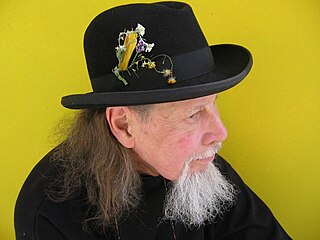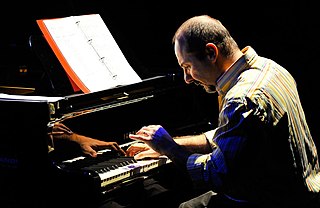| I Like America and America Likes Me | |
|---|---|
 | |
| Artist | Joseph Beuys |
| Year | 1974 |
| Medium | Performance, documentary photographs, video |
I Like America and America Likes Me, also known as Coyote, was a 1974 performance by conceptual artist Joseph Beuys.
| I Like America and America Likes Me | |
|---|---|
 | |
| Artist | Joseph Beuys |
| Year | 1974 |
| Medium | Performance, documentary photographs, video |
I Like America and America Likes Me, also known as Coyote, was a 1974 performance by conceptual artist Joseph Beuys.
In 1974, the German conceptual artist landed in a New York City airport whereupon assistants wrapped him in felt and brought him to the René Block Gallery in SoHo in an ambulance. There Beuys spent three consecutive days, for eight hours a day, living with a live coyote. Beuys attempted to connect with the animal by repeating symbolic gestures such as throwing leather gloves, gesticulating with a cane, and cloaking himself like a shepherd with the cane sticking out. The coyote was docile and occasionally hostile, tugging at the artist's felt. [1] Beuys occasionally played a triangle and a tape recording of turbines. [2]
At the end of the performance, Beuys, still wrapped in felt, returned home in the same manner whence he came. [1]
Caroline Tisdall, Beuys's collaborator and travel companion, documented the performance in black and white photographs. [3]
At the time of this performance, Beuys was already well known as a provocative German visual artist who used materials—felt and animal fat—based on his mythologized personal history: As a downed fighter pilot, a Tartar tribesman nursed Beuys back to health by insulating him in those materials. The felt in which Beuys wrapped himself during I Like America and America Likes Me was a therapeutic and shamanic symbol for Beuys through which he and his "social sculptures" (such as this performance) sought to heal societal psychic wounds. [1]
During this time, Beuys saw the United States as divided over its involvement in the Vietnam War and its racial divisions and subjugation, and wanted his performance to address the split between Native and European intelligence, the latter being more materialistic, mechanistic, and positivistic. His selection of the coyote, a Native American symbol of transformation and trickery, invoked its Native creation myth of the Promethean teacher teaching humans to survive. Whereas settlers viewed coyotes as an aggressive predator to be exterminated, to Beuys, the coyote symbolized America's spirit. Beuys felt that America needed to reckon with the coyote to lift its trauma. [1] It was Beuys's first trip to the United States. He had refused prior invitations based on American involvement in the Vietnam War, but agreed to travel given the country's exit from the war. [4]
The performance's title, I Like America and America Likes Me, also recalls the 7-Up soda advertising slogan, [5] "You like it. It likes you." [6] The piece is also known as Coyote. [7]
The performance's lesson, wrote Artsy, is that American societal trauma can only be healed through direct communication. [1]
Artsy wrote that the piece's title, evoking the melting pot metaphor for Americanization, stood in contrast with the divisions Beuys saw in America. [1]
Photographs from the performance were shown at the Edinburgh Festival, where they greatly affected the future artist Jimmy Boyle. [3] The curator RoseLee Goldberg too found the photographs poetic, only to be changed by a video of the performance in which she saw the sadness of the coyote. [8] Artifacts from the performance were later exhibited in "Neues vom Coyoten" ("News from the Coyote") at the Ronald Feldman Gallery. [9]

Performance art is an artwork or art exhibition created through actions executed by the artist or other participants. It may be witnessed live or through documentation, spontaneously developed or written, and is traditionally presented to a public in a fine art context in an interdisciplinary mode. Also known as artistic action, it has been developed through the years as a genre of its own in which art is presented live. It had an important and fundamental role in 20th century avant-garde art.

Modern art includes artistic work produced during the period extending roughly from the 1860s to the 1970s, and denotes the styles and philosophies of the art produced during that era. The term is usually associated with art in which the traditions of the past have been thrown aside in a spirit of experimentation. Modern artists experimented with new ways of seeing and with fresh ideas about the nature of materials and functions of art. A tendency away from the narrative, which was characteristic of the traditional arts, toward abstraction is characteristic of much modern art. More recent artistic production is often called contemporary art or postmodern art.

Joseph Heinrich Beuys was a German artist, teacher, performance artist, and art theorist whose work reflected concepts of humanism, sociology, and anthroposophy. He was a founder of a provocative art movement known as Fluxus and was a key figure in the development of Happenings.
Madeline Charlotte Moorman was an American cellist, performance artist, and advocate for avant-garde music. Referred to as the "Jeanne d'Arc of new music", she was the founder of the Annual Avant Garde Festival of New York and a frequent collaborator with Korean American artist Nam June Paik.

Willoughby Sharp was an American artist, independent curator, independent publisher, gallerist, teacher, author, and telecom activist. Avalanche published interviews they conducted with contemporary artists such as Vito Acconci, Dennis Oppenheim and Yvonne Rainer. Sharp also was contributing editor to four other publications: Impulse (1979–1981); Video magazine (1980–1982); Art Com (1984–1985), and the East Village Eye (1984–1986). He published three monographs on contemporary artists, contributed to many exhibition catalogues, and wrote on art for Artforum, Art in America, Arts magazine, Laica Journal, Quadrum and Rhobo. He was editor of the Public Arts International/Free Speech documentary booklet in 1979. Sharp received numerous grants, awards, and fellowships; both as an individual or under the sponsorship of non-profit arts organizations.
Linda Connor is an American photographer living in San Francisco, California. She is known for her landscape photography.
Arnaud Maggs was a Canadian artist and photographer. Born in Montreal, Maggs is best known for stark portraits arranged in grid-like arrangements, which illustrate his interest in systems of identification and classification.
In art, appropriation is the use of pre-existing objects or images with little or no transformation applied to them. The use of appropriation has played a significant role in the history of the arts. In the visual arts, "to appropriate" means to properly adopt, borrow, recycle or sample aspects of human-made visual culture. Notable in this respect are the readymades of Marcel Duchamp.
Douglas Matthew Davis, Jr. was an American artist, critic, teacher, and writer for among other publications Newsweek.
The Joseph Beuys Media Archive is an institution affiliated with the Museum of Contemporary Art, Berlin and the Joseph Beuys Estate, Düsseldorf. Its purpose is to collect, archive, digitize, and publicize the work of the German artist Joseph Beuys.
How to Explain Pictures to a Dead Hare is a performance piece staged by the German artist Joseph Beuys on 26 November 1965 at the Galerie Schmela in Düsseldorf. While it was only Beuys’s first solo exhibition in a private gallery, it is sometimes referred to as his best known action.

Umberto Petrin is an Italian jazz pianist, composer and poet. He devoted himself to the study of the piano at the age of 12. After studying Chemistry, he graduated in Piano at the Giuseppe Verdi Conservatory in Milan, where he is now Professor of Jazz Piano. From the age of 18 he took an active interest in contemporary poetry and began a long collaboration with literary magazines, winning several prizes and being a finalist in numerous poetry competitions.
Gallery Hyundai was founded in 1970, initially located in Insadong, South Korea. The founder and president of the gallery, Park Myung-ja introduced modern and contemporary art to the Korean public. Many exhibitions were held throughout the past four decades, including paintings by Philippe Pasqua, Lee Ufan, Kim Tschangyeul, Kim Whanki, Lee Joongseob, Chung Sanghwa and Park Su-geun. Also video artist, Paik Nam June held multiple solo exhibitions at Gallery Hyundai, and in 1990, Paik performed a shamanic ritual called A pas de Loup de Séoul à Budapest in the back courtyard of Gallery Hyundai to commemorate Joseph Beuys' death. Starting from 1987, Gallery Hyundai started to participate in international art fairs such as Art Chicago, FIAC, Art Basel, Frieze Masters London (2014) and Frieze New York(2012–2015). Gallery Hyundai moved its location to Sagan-dong (Samcheong-ro) in 1975. 2015 marks Gallery Hyundai's 45th anniversary since its opening.
Performa is a non-profit arts organization well-known for the Performa Biennial, a festival of performance art that happens every two year in various venues and institutions in New York City. Performa was founded in 2004 by art historian and curator RoseLee Goldberg. Since 2005, Performa curators have included Charles Aubin, Defne Ayas, Tairone Bastien, Mark Beasley, Adrienne Edwards, Laura McLean-Ferris, Kathy Noble, Job Piston, and Lana Wilson. The organization commissions new works and tours performances premiered at the biennial. It also manages the work of choreographer and filmmaker Yvonne Rainer.
Hamidou Maiga is a Malian studio photographer among the region's pioneers in the craft during the postcolonial period. His work was largely unknown in the West prior to his discovery and display in the early 2010s. Maiga's early outdoor portraits from the Niger River region in the late 1950s reflect Mali's period of societal transition from colony to sovereignty. He has exhibited in solo shows in London and Lima, Peru.
Marcia Grostein Marcia Grostein is a Brazilian-American artist known for using various mediums across public art, sculpture, painting, video art, photography, and portable wearable art/jewelry. She was the first contemporary Brazilian artist to be acquired by the Metropolitan Museum of Art for the 20th Century Collection by the curator Lowery Sims.
John Halpern a.k.a. John DiLeva Halpern is a filmmaker, conceptual artist, and performance artist based in New York City. He is known for cultural activism and documentaries about art, artists, and Tibetan Buddhism.
Legacy Russell is an American curator, writer, and author of Glitch Feminism: A Manifesto, published by Verso Books in 2020. In 2021, the performance and experimental art institution The Kitchen announced Russell as the organization's next executive director and chief curator. From 2018 to 2021, she was the associate curator of exhibitions at the Studio Museum in Harlem.
Guadalupe Maravilla, formerly known as Irvin Morazan, is a transdisciplinary visual artist, choreographer, and healer. At the age of eight, Maravilla was part of the first wave of unaccompanied, undocumented children to arrive at the United States border in the 1980s as a result of the Salvadoran Civil War. In 2016, Maravilla became a U.S. citizen and adopted the name Guadalupe Maravilla in solidarity with his undocumented father, who uses Maravilla as his last name. As an acknowledgment to his past, Maravilla grounds his practice in the historical and contemporary contexts belonging to undocumented communities and the cancer community. Maravilla's studio is located in Brooklyn, New York.
Ronald Feldman was an American art dealer and advocate for the arts, especially contemporary performance and conceptual art.
{{cite book}}: CS1 maint: numeric names: authors list (link)